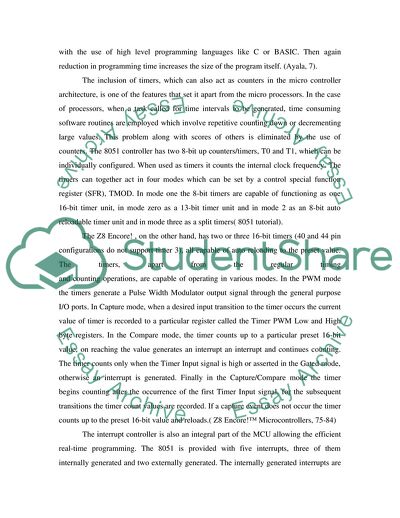
- Home
- Free Samples
- Premium Essays
- Editing Services
- Extra Tools
- Essay Writing Help
- About Us
- Studentshare
- Subjects
- Miscellaneous
- Microprocessor Systems (Micro-controller Research)
Microprocessor Systems (Micro-controller Research) - Essay Example

- Subject: Miscellaneous
- Type: Essay
- Level: Masters
- Pages: 4 (1000 words)
- Downloads: 0
- Author: pacochaedison
Extract of sample "Microprocessor Systems (Micro-controller Research)"
how ever has a number of pin configurations ranging from 40 pin up to 80 pin packages with a maximum of 60 general purpose I/O pins. The Z8 Encore has RAM memory of 4KB and Programmable Flash Memory of 64 KB (Z8 Encore!™ Microcontrollers with Flash Memory and 10-Bit A/D Converter, 19). Both Z8 Encore! and the 8051 microcontrollers operate with an 8-bit CPU with the former working at maximum clock frequency of 16Mhz and the later at 20Mhz. . However with the 8051 MCU, of the 32 working registers, only 2 registers (A and B) hold the results of the ALU.
The accumulator register A is the more versatile of the two and is used for data transfers between 8051 and external memories(Ayala,61). The CPU of the Z8 Encore! supports direct register to register architecture which allows all the available general purpose registers to act as accumulators thereby increasing the execution time. The CPU supports additional op-codes also employs instruction pipelining and is capable of executing instructions at speeds up to 10 MIPS(Z8 Encore!™ Microcontrollers, 21-22).
The Z8 Encore! is compatible with the existing instruction set of the Z8 family. While the Z8 instruction set is very rich (71% of the total number of instructions is multi-byte), it results in slower execution times. The 8051 micro-controller has a “leaner” instruction set (only 62% of the instructions are multi-byte) and hence can complete tasks at a faster rate. However with leaner instruction sets comes the disadvantage of increase in programmer effort and time, which in turn can be reduced with the use of high level programming languages like C or BASIC.
Then again reduction in programming time increases the size of the program itself. (Ayala, 7). The inclusion of timers, which can also act as counters in the micro controller architecture, is one of the features that set it
...Download file to see next pages Read More
- TERMS & CONDITIONS
- PRIVACY POLICY
- COOKIES POLICY